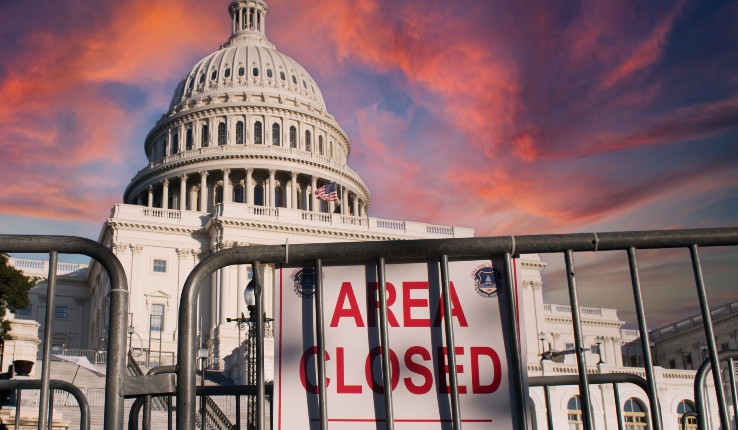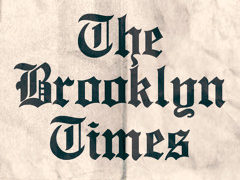
Credit: iStock/Douglas Rissing
Political scientist Anthony DiMaggio, in new book, says fighting fascism must become a regular topic of conversation in homes, schools and elsewhere.
To dismantle the threat of fascist politics in the U.S., the people must emerge from denial that it has taken root. Fighting fascism must become a regular topic of conversation in homes, schools, media and everywhere else discussions about the future of the nation take place.
So concludes political scientist Anthony DiMaggio in his new book “Rising Fascism in America: It Can Happen Here.” The sub-title refers to Sinclair Lewis’s 1935 dystopian novel, “It Can’t Happen Here.”
Lewis’s novel charts the rise of a populist demagogue, Buzz Windrip, an aspiring fascist meant to mirror the rise of German dictator Adolf Hitler. Windrip is dismissed as a joke. The novel’s hero, Doremus Jessup, attempts to sound the alarm.
DiMaggio’s book functions as an alarm-sounder, too—though he acknowledges that fascist politics are not the same as a fascist government.
“To be clear, I am not arguing that the United States is a fully consolidated fascist country—equivalent in its political institutions to what existed in Germany and Italy between 1922 and 1945,” writes DiMaggio. “The United States is not a one-party dictatorship. Rather, the concern is with the threat of a rising fascistic movement to the stability of the republic, which is to say that undercurrents, or elements of fascistic politics in America have steadily grown more extreme in recent decades, particularly in recent years under Trump’s presidency.”
While the book’s cover image features a photo of former U.S. President Donald Trump at a rally, DiMaggio repeatedly points out that while Trump may have successfully leveraged fascistic political leanings, he rode a wave that was already in progress.
Trump “…rose to power because of the longstanding cultivation of racist, authoritarian, and xenophobic beliefs on the American right in the years and decades running-up to his election in 2016,” writes DiMaggio.
Political scientist Anthony DiMaggio’s new book is titled “Rising Fascism in America: It Can Happen Here.”
He points to a number of societal “enablers” who contributed to creating the fertile ground for “a neofascistic political movement” to flower. These include scholars, journalists, the Democratic Party and neoliberals who, he says, all downplayed fascistic political movements and the dangers of Trump’s rise. One example he cites is the media use of the word “populist” to describe presidential candidate Trump, which helps to avoid unpleasant discussions about the problem of a rising fascistic movement in the United States.
“It is not so much that populism is ‘wrong’ as a way of framing Trump and his politics, so much as it is a vague and less critical way of portraying his politics,” writes DiMaggio. “Furthermore, it obscures the authoritarian and neofascistic components of Trump’s politics.”
Just as hollow opposition had a role to play in the rise of American fascism as depicted by Lewis in “It Can’t Happen Here,” DiMaggio points to evidence that Democratic Party politics played a role in feeding the fascist politics leveraged by Trump. He cites, in particular, changes ushered in by President Bill Clinton in the 1990s, when the Party, “…shed its commitment to poverty and inequality reduction, regulation of business, and other progressive reforms.” These policies significantly increased public disillusionment with the party, depressing voter turnout among disadvantaged groups, thereby paving the way for Trump’s electoral victory in 2016.
This extremism has been building for decades with rightwing media pundits’ embrace of increasingly conspiratorial, authoritarian, racist and xenophobic messages, which has gone unacknowledged for the most part in mainstream political and academic discourse.
Anti-Labor policies of the Clinton years, asserts DiMaggio, continued under President Barack Obama’s administration. The Obama era, similar to the 1990s, he writes “…is largely remembered for rising corporate power and inequality.”
DiMaggio details the key role that propaganda has played and continues to play in fueling fascist politics. He points to several “Trojan Horses” responsible for mainstreaming extremist viewpoints such as pundit Alex Jones and outlets including Infowars and Breitbart, which he refers to as “alt-light.”
“This extremism has been building for decades with rightwing media pundits’ embrace of increasingly conspiratorial, authoritarian, racist and xenophobic messages, which has gone unacknowledged for the most part in mainstream political and academic discourse,” he writes.
One chapter details the rise of “Trumpism” and the various movements that coalesced and strengthened during his time as president, such as QAnon and the “Reopen” movement. DiMaggio points to the 2017 “Unite the Right Rally” in Charlottesville, Virginia―when a gathering of White supremacists, neo-Confederates and others who came to Charlottesville to protest the removal of a statue of Confederate General Robert E. Lee resulted in violence and death―as a key moment in the rise of neo-fascist politics, calling it the movement’s “coming out party.”
“Trump refused to clearly condemn the reactionary right, relying on false equivalencies, Orwellian double-talk and romanticization of Confederate politics,” writes DiMaggio. “He ‘condemn[ed] in the strongest possible terms’ the ‘egregious display of hatred, bigotry and violence,’ in Charlottesville ‘on many sides,’ thereby drawing a false equivalency between neo-fascists who idealized White supremacy and activists who opposed it.”
DiMaggio also examines the rise of resistance and anti-fascist movements during the Trump era, including Black Lives Matter and the #MeToo movement. He looks at the militant group known as “Antifa,” questioning its lack of transparency as an effective strategy for movement-building and points to alternatives such as Refuse Fascism, an organization that is “…devoted to broader, more encompassing educational efforts that aim to spotlight the threat of a rapidly mainstreaming neofascistic movement….”
In the book’s conclusion, DiMaggio argues that any notion that the “beast had finally been slain” when Trump was defeated in the 2020 election, is “incredibly misplaced.” The Jan 6 insurrection at the nation’s capital and the ongoing perpetuation of a false narrative Biden’s election is illegitimate have set the stage for the movement’s growth, as well as, potentially, the rejection of elections anytime a Democrat is elected, he argues.
The “central challenge moving forward,” he writes, will be fighting “…the underlying commitment to racism, misogyny, xenophobia and neofascistic politics that made Trumpism possible, and the Republican Party’s growing commitment to White supremacy, authoritarianism and its eliminationist attachment to one-party rule, contract to the steady and rising demographic diversification of the nation.”
DiMaggio finds hope that a nascent antifascist movement could continue to grow, though he is realistic about the challenges.
He writes: “Put simply, any effective antifascist movement will not be won with fists in the streets, but by reaching millions of American minds in classrooms and through public political dialogue and discourse. In a country suffering from the sort of mass fascist denial that is pervasive in the United States, and considering the severity of the threat from this rising neofascistic movement, the commitment from antifascists must be even greater and involve a critical mass of educators operating across primary, secondary and collegiate educational institutions, stressing the dangers of rising rightwing extremism to democracy in America.”




